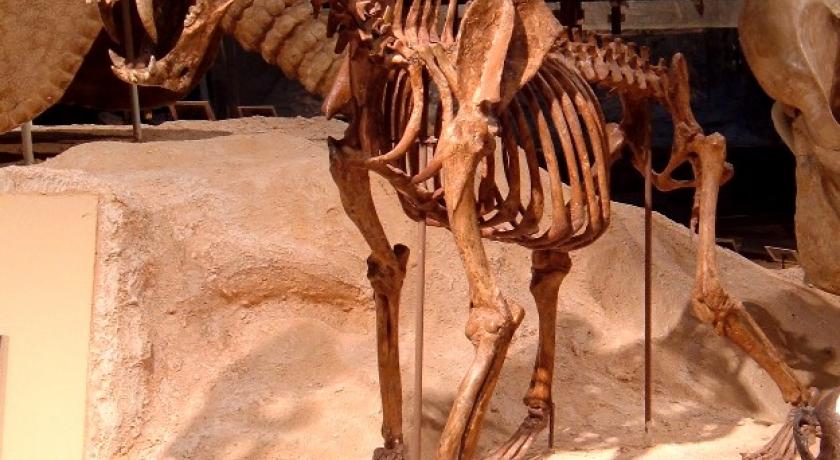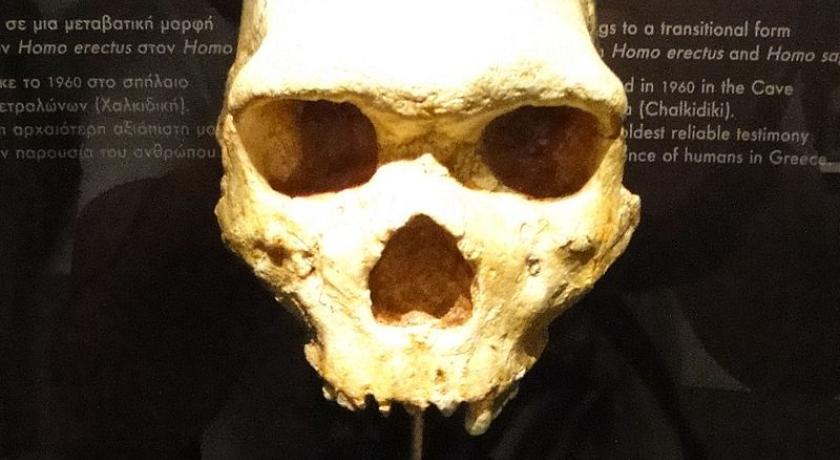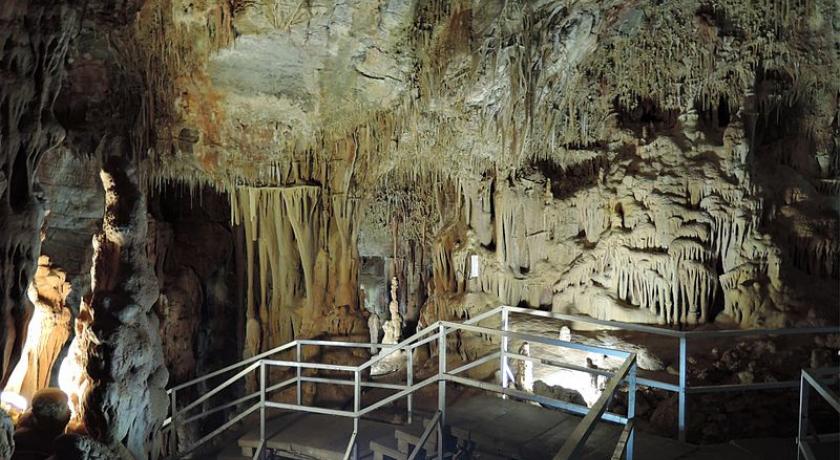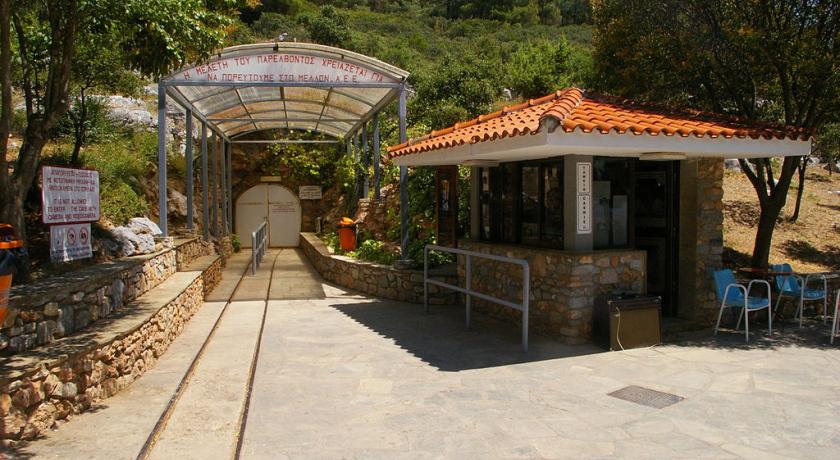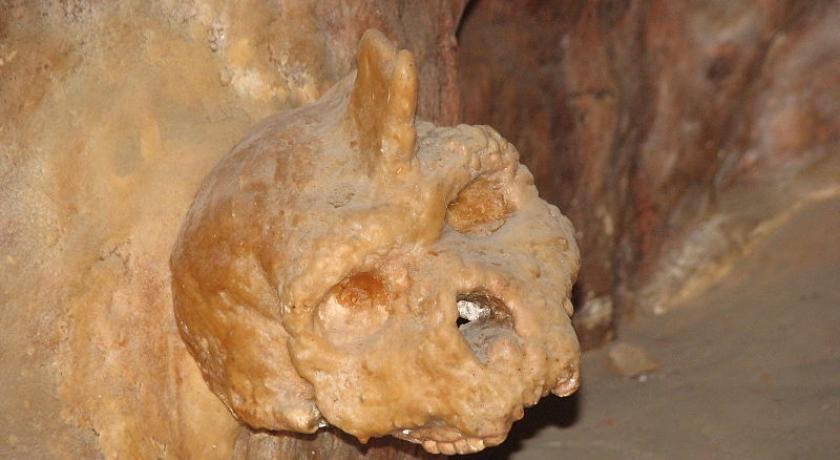Description
The Petralona cave (Greek: Σπήλαιο Πετραλώνων) also Cave of the Red Stones (Greek: Σπήλαιο " Κόκκινες Πέτρες "), a Karst formation - is located at 300 m (984 ft) above sea-level on the western foot of Mount Katsika, 1 km (1 mi) east of the eponymous village, about 35 km (22 mi) south-east of Thessaloniki city on the Chalkidiki peninsula, Greece. The site came to public attention when in 1960 a fossilized hominid skull was found. The cave had been discovered accidentally only a year earlier (1959) after erosion had left clefts in the rock. "Bejeweled" with impressive stalactite and stalagmite formations and holding an abundance of fossils the cave soon attracted geologists and paleontologists. After decades of excavations the cave is open to the public and scientific work is documented and presented in an adjacent Archaeological Museum.
The cave's most prominent fossil specimen, since known among paleoanthropologists as the "Petralona Skull", named Archanthropus europaeus petraloniensis by Aris Poulianos, former head of the Anthropological Association of Greece. He considers it the oldest European hominid ever found and assessed it to be 800.000 years old. Yet "there was the constant problem that the skull was an isolated find" as other scientists strongly disagree and the find has been a continuing cause of controversy since. The Anthropological Association's conclusions and results are in direct conflict with accepted speciation models of the genus Homo and the chronology of the Out of Africa theory.
For a number of times excavations on the site were delayed and/or had to be discontinued, first in 1967 and the following years in relation to the Greek coup d'état, again in 1983, according to Nickos A. Poulianos the Ministry of Culture giving no reason why it ceased to re-issue the excavation concession until "in 1997 the Anthropological Association of Greece, after 15 years of trials, was justified by the Supreme Court and was ordered the continuation of its works in the cave." Dr. Aris Poulianos, President of the Anthropological Association of Greece has repeatedly accused the Greek government, claiming it is conspiring to suppress his discoveries as in 2012 excavation rights were revoked again.
The on-site Anthropological Museum of Petralona displays a selection of the cave's findings.
Discovery
The cave was discovered accidentally in 1959 by Fillipos Chatzaridis, a local shepherd who was looking for a spring. In his effort to find a water source he found a small cleft on the slopes of Mount Katsika. Two men were lowered down and later described a large number of chambers and corridors, totaling 8 to 10 meters high with rich and beautiful formations of speleothems (stalactites and stalagmites).
The cave developed during the Mesozoic (Jurassic) limestone, its sediments are divided into several stratigraphic levels. "The rock formations resemble giant cactus, pink pearls, sturdy columns or delicate curtains, and in several places water ponds are fed by stalactite material. Covering an area of 10,400 m2 (111,945 sq ft), the length of the corridors is about 2,000 m (6,562 ft) and temperature throughout the year remains stable at 17 ° C (± 1 º C)." The first research of 1959 was undertaken by the Greek speleologist Ioannis Petrocheilos. He found numerous bones of animals, many of them covered with cave coral.
The Skull
The skull of the Archanthropus was according to Aris Poulianos found by another villager, Christos Sariannidis in 1960, hanging at the wall about 30 cm (12 in) above ground, where it was held by sinter. Aris N. Poulianos states, that "early estimates at the time placed the age of the hominid remains to around 70,000 years". The Petralona skull, its lower jaw missing and completely "encrusted by brown calcite soon after the death of the individual" was estimated to be about 700,000 years old by Dr. Aris Poulianos, head of the excavation team since 1965. He announced that "the date was based on analyses of the cave’s stratigraphy and the accumulated sediments".
In 1981, the age of the Petralona skull deduced by Poulianos was investigated and the protocol published in the Nature journal. The scientists involved used electron spin resonance measurements of the calcite encrustation and of bone fragments and dated the age of the skull to between 160,000 and 240,000 years. However, Poulianos states that his excavations in the cave since 1968 provide evidence of human occupation from the Pleistocene era. The Petralona hominid, specifically, was located in a stratigraphic layer containing the highest amount of tools and traces of habitation. Poulianos claims that the age of the overall layer is approximately 670,000 years old, based on electron spin resonance measurements. Other researchers point out, that contextual animal fossils "found with it are known elsewhere from approximately 350,000 years ago". In 1987 researchers announced that the cranium can't be older than 620.000 years after palaeo-magnetic and mineral magnetic studies of the cave's sediments.
Layer 10
In 1992 an international team published its results of a Uranium-series dating analysis of the small cavern, called "The Mausoleum" where the skull was allegedly found and the sediments, named "Layer 10" by Poulianos. The results confirm earlier findings "that the whole of layer 10 represents a long time span, from about 160 ka to more than 350 ka". The minimum age refers to the brown calcite layer, that covered and cemented the hominid skull to the wall. The fossils encrustation is insufficient to date it by alpha-spectrometric, Uranium-series methods, yet its minimum age was concluded to be also 160.000 years.
Today, most academics who have analyzed the Petralona remains classify the hominid as Homo erectus. However, the Archanthropus of Petralona has also been classified as a Homo heidelbergensis, Neanderthal (Homo sapiens neanderthalensis) and as an early generic class of Homo sapiens. A. Poulianos, on the other hand, believes that the Petralona cranium is derived from an independent class of hominids unrelated to Homo erectus.
Runnels and van Andel summarise the situation as such : "The only known hominid fossil in Greece that may be relevant is the Petralona hominid, found by chance in 1960 in a deep cavern in the Chalkidiki. Controversy surrounds the interpretation of this cranium, and it has been variously classified as Homo erectus, as a classic Neanderthal (Homo neanderthalensis), and as an early representative of Homo sapiens in a generalized sense. The consensus among today's paleoanthropologists [is centered around the idea] that the cranium belongs to an archaic hominid distinguished from Homo erectus and both the classic Neanderthals and anatomically modern humans. Whatever the final classification may be, the cranium has been provisionally dated to ca. 200-400 thousand years old and it is thus possible that the Petralona hominid is a representative of the lineage responsible for the Thessalian Lower Paleolithic sites."
The Anthropological Association of Greece has continued to announce new findings in the cave, such as 4 isolated teeth, then two 800,000 year old pre-human skeletons, a great number of fossils of various species, evidence of the oldest use of fire known to this day and a 11 Million years old girl. Ignoring scientific methodology, these statements were to supplement wanton conclusions and pseudo-scientific theories. Serious publishers such as Nature or Science refuse to publish the Anthropological Association's submissions.
The fossils are preserved at the Geology School of the Aristotle University of Thessaloniki since 1960.
Fossil fauna
Animal fossils of numerous species were found in the cave:
Fish
- indeterminate species
Amphibians
- Bufo bufo (Linnaeus) (common toad)
- Pelobates fuscus Laurenti (a species of toad)
Reptiles
- Testudo graeca Linnaeus (spur-thighed tortoise)
- Testudo sp. (giant)
- Varanus intermedius Bolkay
- Lacerta trilineata (Betriaga) (Balkan green lizard)
- Lacerta viridis (Laurenti) (European green lizard)
- Lacerta sp. (small) (lizards)
- Ophidia indet. (snakes)
Birds
- Anser anser Linnaeus (greylag goose)
- Aythya ferina Linnaeus (common pochard)
- Fulica atra Linnaeus (eurasian coot)
- Buthierax pouliani Kretzoi (extinct species of eagle)
- Falco tinnunculus Linnaeus (common kestrel)
- Alectoris sp. (species of partridges)
- Alectoris graeca mediterranea Maurer-Chauvire' (rock partridge)
- Perdix jurcsaki (Kretzoi) (a species of partridge)
- Scolopacidae indet. (family of waders or shorebirds - sandpipers, curlew, snipe and other associated species)
- Larus sp. (a genus of gulls)
- Columba oenas ssp. (stock dove)
- Columba livia ssp. (rock pigeon)
- Columba palumbus Linnaeus (common wood pigeon)
- Strix aluco Linnaeus (tawny owl)
- Glaucidium Linnaeus (pygmy owls)
- Bubo (?) sp. (horned owl and associated species)
- Corvus corax Linnaeus (common raven)
- Pyrrhocorax graculus vetus Kretzoi (alpine chough)
- Turdus sp. (a genus of true thrushes)
- Lanius minor Gmelin (lesser grey shrike)
- Prunella collaris Scopoli (alpine accentor)
- Passeriformes indet. I, II
Mammals
-
- Insectivore
- Erinaceus europaeus praeglacialis Brunner (preglaciation European hedgehog )
- Sorex minutus Linnaeus (Eurasian pygmy shrew)
- Sorex runtonensis (Hinton)
- Pachyura etrusca (Savi)
- Talpa minuta Freudenberg (a genus of moles)
Primates
- Archanthropus europaeus petraloniensis Α. Poulianos
Chiroptera (bats)
- Rhinolophus sp. indét. I, II
- Rhinolophus ferrumequinum topali Kretzoi (a sub-species of greater horseshoe bat)
- Rhinolophus mehelyi Matschie (Mehely's horseshoe bat)
- Rhinolophus hipposideros Bechstein (lesser horseshoe bat)
- Miniopterus schreibersii Kuhl (common bent-wing bat)
- Myotis sp. indét. I, II (genus of mouse-eared bats)
- Myotis myotis Borkhausen (greater mouse-eared bat)
- Myotis blythi oxygnathus Monticelli
- Myotis blythi ssp.
- Myotis emarginatus Geoffroy (Geoffroy's bat)
- Myotis daubentonii (Kuhl) (Daubenton's bat)
- Vespertilio murinus Linnaeus (particoloured bat)
- Hypsugo savii Bonaparte (Savi's pipistrelle)
- Eptesicus sp. (a genus of bats)
- Nyctalus noctula (Schreber) (common noctule)
- Pipistrellus (?) sp. (a genus of bats)
Lagomorpha
- Lepus terraerubrae (Kretzoi)
- Oryctolagus sp. (European rabbit)
Rodents
- Urocitellus primigenius daphnae Kretzoi (extinct species of Urocitellus or ground squirrel)
- Hystrix sp. (a genus of porcupines)
- Gliridae indet. (a genus of dormouse)
- Dryomimus eliomyoides arisi Kretzoi
- Parasminthus brevidens Kretzoi
- Spalax chalkidikae Kretzoi
- Apodemus mystacinus crescendus Kretzoi
- Mus synanthropus (Mus (Budamys) synanthropus) Kretzoi (a sub-species of Mus)
- Allocricetus bursae simplex Kretzoi (a sub-species of hamsters - see Allocricetulus)
- Lagurus transiens Janossy (a species of Lagurus - voles, lemmings, and related species)
- Eolagurus argyropuloi zazhighini Ν. Poulianos (a genus of rodents)
- Arvicola cantiana Heinrich (a species of vole)
- Microtus praeguentheri Kretzoi (a species of vole)
Carnivorans
- Canis lupus mosbachensis Soergel (espèce préhistorique de loup)
- Cuon priscus Thenius (Early Middle Pleistocene dhole or wild dog)
- Xenocyon lycaonoides Kretzoi
- Vulpes praeglacialis Kormos (extinct species of vulpes - true fox)
- Meles meles atavus ? (Kormos) (primitive European badger)
- Ursus stehlini ? (Kretzoi)
- Ursus deningeri Reichenau
- Crocuta petralonae Kurten
- Pachycrocuta brevirostris Aymard (a sub-species of prehistoric hyenas)
- Pachycrocuta perrieri Croizet & Jobert (a sub-species of prehistoric hyenas)
- Panthera leo fossilis Reichenau (primitive cave lion)
- Panthera gombaszoegensis Kretzoi (European jaguar)
- Panthera pardus Linnaeus (leopard)
- Felis silvestris hamadryas ? (Kurten) (species of wild cat)
- Homotherium sp. (close to the sabertooth tiger)
Proboscidea
- Elephas sp. (genus of elephants)
Perissodactyla
- Equus mosbachensis (Reichenau)
- Equus hydruntinus ssp. (European ass)
- Equus stenonis petraloniensis Tsoukala
- Stephanorhinus hundsheimensis Toula (a species of Stephanorhinus - rhinoceros)
Artiodactyla
- Sus scrofa ssp.(wild boar)
- Dama dama ssp. (Fallow deer|fallow deer)
- Cervus elaphus ssp. (red deer)
- Praemegaceros verticornis ? (Dawkins) (a genus of large deer - see Megaloceros verticornis)
- Capra ibex macedonica Sickenberg (a sub-species of alpine ibex)
- Bison schoetensacki (Freudenberg) (European wood bison)
Source: https://en.wikipedia.org/wiki/Petralona_cave
Address
eponymous village
Griekenland
Lat: 40.373104095 - Lng: 23.167598724


